KEY SERVICE MEASURES
1. Patronage and Services Provided
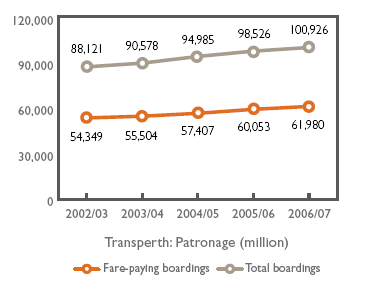
In 2006/07, total boardings on Transperth services recorded an increase of 2.4% and exceeded 100 million for the first time. Fare-paying boardings increased by 3.2%.
Total boardings are fare-paying boardings, free travel on passes, free travel on Central Area Transit services in Perth, Fremantle and Joondalup and free travel of services within the Perth Free Transit Zone, plus transfers between services.
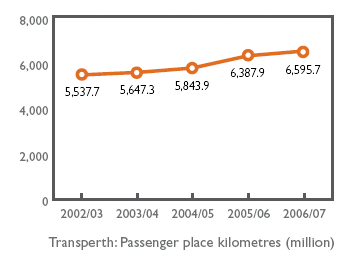
Passenger place kilometres is based on service kilometres and the average capacity of the fleet and represents the total capacity provided on the Transperth bus, train and ferry network. The expansion of the train network through the establishment of new stations at Clarkson, Greenwood, and Thornlie and the introduction into service of three- and six-car trains were the main factors that led to the expansion of capacity on the Transperth system after 2004/05. Between 2004/05 and 2005/06, train passenger place kilometres increased by 23.1% and total system capacity by 9.3%. In 2006/07, the intensive use of three- and six-car trains resulted in train passenger place kilometres recording a growth rate of 6.2% which helped to increase total system capacity by 3.3%. The contribution of the bus network to the increase in passenger place kilometres over the past five years has been modest due to the relatively low rate of increase in bus service kilometres over this period.
2. Access to Public Transport
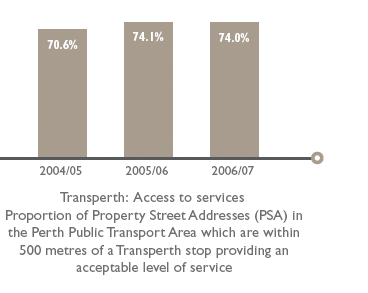
The graph seeks to highlight the relative ease with which the community can access Transperth services. The ease of access is represented by the proportion of property street addresses within the Perth Public Transport Area that are within walking distance of a Transperth stop providing an acceptable level of service.
3. Reliability
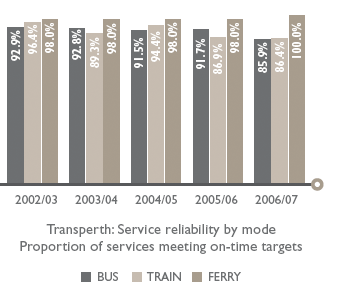
During 2006/07, Transperth adopted more precise methods of gathering data to measure service reliability on all modes. From January 2007, bus and ferry on-time running was measured using the SmartRider ticketing system’s “GPS Reporter” functionality. This resulted in a significant reduction in the proportion of bus services meeting the on-time target in 2006/07. Ferry services achieved a 100% result. On trains, the on-time module of the new train control system was brought into operation from January 2007 and resulted in a higher proportion of services not meeting the target, 13.6% in 2006/07 compared with 5.6% in 2004/05. Note that the result in 2005/06 was affected by the Southern Suburbs Railway works program.
4. Passenger Satisfaction
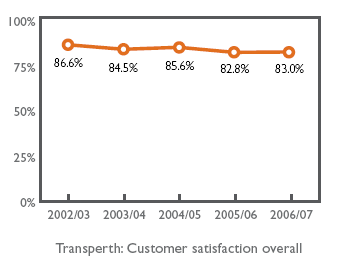
An independent market research firm commissioned by Transperth carries out an annual Passenger Satisfaction Monitor to assess the level of satisfaction/dissatisfaction among patrons in respect of various aspects of all the services provided by Transperth. The graph shows the proportion of respondents who expressed satisfaction with the overall level of service on Transperth bus, train and ferry services, calculated as the weighted average across all modes.
5. Passenger Safety
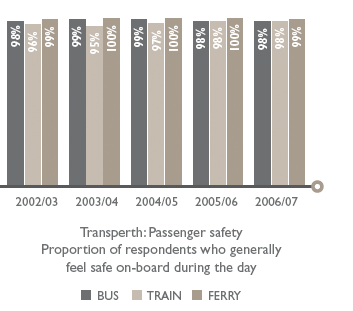
Note: Measures relating to customer perception of safety at other times and at stations/interchanges are shown in sections dealing with individual modes.
The Passenger Satisfaction Monitor assesses customer perception of safety during the day and at night-time, on-board bus, train and ferry, and at bus and train stations and ferry jetties. The graph shows that nearly all passengers feel safe on-board Transperth vehicles during the day.
6. Efficiency
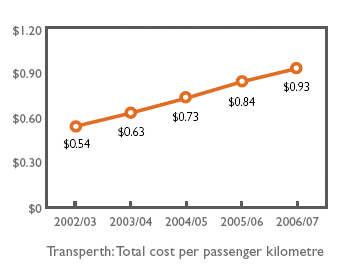
The increase in the cost per passenger kilometre over five years to 2006/07 was primarily due to:
- Expansion of the urban train network through extension of the Northern Suburbs line to Clarkson (commissioned in October 2004), the opening of the Thornlie Line (August 2005), the commissioning of 93 additional railcars and the capital charges and pre-implementation operating costs associated with the Southern Suburbs Railway. Transperth capital charges (interest, depreciation and Capital User Charge) increased four-fold to $177.9 million over five years to 2006/07. Capital charges represent 40% of the total operating cost. The increase was primarily attributed to train operations,
- Improvements in security in trains and stations, and
- Increased costs of labour, fuel and maintenance for the provisions of bus services.
During 2006/07, Transperth train operations recruited 243 railcar drivers, customer service and passenger ticketing assistants and other train system support personnel in readiness for the commissioning of the Southern Suburbs Railway, and the implementation of fare gate management at stations in conjunction with the SmartRider roll out.
Operating costs for provisions of security and customer service and maintenance of the railcar fleet doubled over the period to 2006/07 to $33.5 million and $22.1 million respectively.
Since 2002/03 passenger kilometres increased by 84.5 million to 622.2 million in 2006/07. The Transperth train system increased by 73.4 million passenger kilometres (36.5%) to 271.6 million, reflecting the expansion of the network and the introduction of 93 new railcars.
With the introduction of SmartRider, which provided improvements to information on zonal travel, student and concession fare average trip length was recalibrated, resulting in reduction of average trip length on buses. The effect of this recalibration on bus passenger kilometres was a reduction in passenger kilometres of 3.4% compared with 2005/06.
7. Expenditure and Revenue
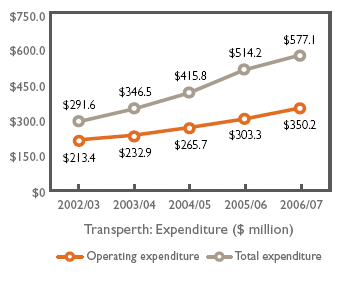
In 2006/07, total expenditure on the Transperth system increased by 12.2% and operating expenditure (which excludes capital charges on long-lasting infrastructure) by 15.5%. While total and operating expenditure on the bus system rose by 1.1% and 4.8% respectively, the train network recorded a significant increase in costs. Total expenditure on trains rose 22.9% due to the 200% increase in the Capital User Charge. This accounted for over half of train capital charges in 2006/07. Train operating expenditure increased by 35.0% primarily due to the recruitment of staff for the “closed” train stations, an integral feature of the new SmartRider ticketing system, and for the Southern Suburbs Railway.
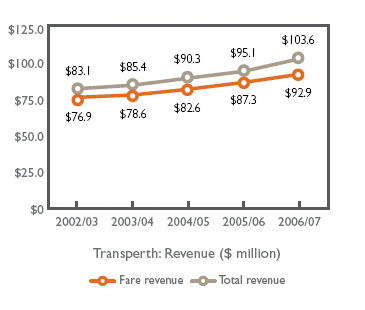
In addition to fares paid by users, fare revenue includes funding for the Perth Central Area Transit (CAT) service and contributions for specific services which are paid to Transperth in lieu of fares. In 2006/07, fare revenue increased by 6.4% due to higher fares (an overall average increase of 4%), and a 3.2% increase in fare-paying boardings. Total revenue, increased by 8.9% in 2006/07, and includes fare revenue and sundry income, e.g. advertising, infringements, rent, etc. Note that sundry income tends to fluctuate.
Joint ticketing revenue more than doubled in 2006/07 to $1.5 million, largely as a result of arrangements with the WA Football Commission.



